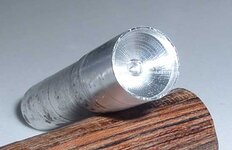Dale Allen
Member
This is a short piece of aluminum stock that I used as a test.
The OD of the aluminum is .465" and I drilled into it about 1/8" with a 27/64" drill bit.
My scroll chuck is a new G3 with pin jaws and it works great.
The thickness of the rim varies between .0215" and .0225"
With the scroll chuck mounted I can see a runout of about .0015" and I get he same reading with the dead center installed. This seems consistent with the thickness variance above.
I spent about 2 hours last night dismantling the headstock of my HF lath. I wanted to get to the main spindle bearings, mainly to get the number off them and look for some replacements. One of them I left in the casting and the other was not removed from the spindle. However, both show no signs of wear and neither 'feel' like the bearings are worn in any way. However, that can be a very subjective way of determining the quality.
There is no change in the runout after re-assembly. It did need the cleaning and lube however. I would guess there is well over 300 hours run time on this lathe.
So, I'm not sure putting in new bearings would help the runout at all as it seems to be in the spindle itself. I would also guess that a new spindle would probably not be any better and may possibly be worse.
Would a runout of .0015" be acceptable? Who has checked theirs and has more or less with no issues?
I'd be interested to know the max runout on some of the new Delta and Jet models.
Yesterday I was at Hartville Hardware and they have the new 1221VS set up. However, I was not more impressed with it over the Delta 46-460. One thing that struck me funny was the fact that any tools you have in the holder above the lower belt access door would need to be removed before you could get the door open. I also detected some side-to-side movement in both the tailstock(not locked down) and the headstock spindle. At some point if it seems the replacement parts issue with Delta is resolved, I may buy one.
The OD of the aluminum is .465" and I drilled into it about 1/8" with a 27/64" drill bit.
My scroll chuck is a new G3 with pin jaws and it works great.
The thickness of the rim varies between .0215" and .0225"
With the scroll chuck mounted I can see a runout of about .0015" and I get he same reading with the dead center installed. This seems consistent with the thickness variance above.
I spent about 2 hours last night dismantling the headstock of my HF lath. I wanted to get to the main spindle bearings, mainly to get the number off them and look for some replacements. One of them I left in the casting and the other was not removed from the spindle. However, both show no signs of wear and neither 'feel' like the bearings are worn in any way. However, that can be a very subjective way of determining the quality.
There is no change in the runout after re-assembly. It did need the cleaning and lube however. I would guess there is well over 300 hours run time on this lathe.
So, I'm not sure putting in new bearings would help the runout at all as it seems to be in the spindle itself. I would also guess that a new spindle would probably not be any better and may possibly be worse.
Would a runout of .0015" be acceptable? Who has checked theirs and has more or less with no issues?
I'd be interested to know the max runout on some of the new Delta and Jet models.
Yesterday I was at Hartville Hardware and they have the new 1221VS set up. However, I was not more impressed with it over the Delta 46-460. One thing that struck me funny was the fact that any tools you have in the holder above the lower belt access door would need to be removed before you could get the door open. I also detected some side-to-side movement in both the tailstock(not locked down) and the headstock spindle. At some point if it seems the replacement parts issue with Delta is resolved, I may buy one.

